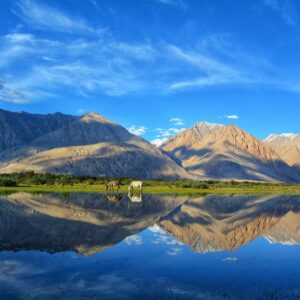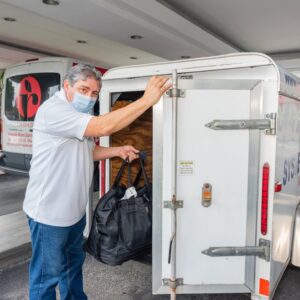Table of Contents
ToggleIntroduction – Why You Need a Solid Guide for Kedarnath Yatra
If you’re planning to visit Kedarnath in 2025, one thing’s for sure—you don’t want to do it blind. This isn’t your average tourist trip; this is a spiritual climb through raw Himalayan terrain. Having done the yatra myself, let me say it plainly: a good guide doesn’t just show you the way—they help you survive, grow, and truly feel the journey.
Kedarnath is more popular than ever this year. Pilgrims are flooding the route, weather is shifting fast, and even experienced trekkers are finding it tough to manage without real support. If you’re not familiar with mountain treks, things can turn tricky fast. That’s why having the right guide isn’t a luxury—it’s a lifeline.
You’ll hear stories about people who made it without a guide. But what you won’t hear often are the moments of panic, fatigue, and near misses along the way. I don’t mean to scare you—but to prepare you. I’ve seen yatris turn back halfway, overwhelmed and unsupported. And then I’ve seen people like myself who made it peacefully—thanks to walking with someone who knew the land better than the map.
Understanding the Route – What Every Yatri Should Know
Before you pick a guide or even start packing, you’ve got to understand what you’re really signing up for. Gaurikund is the starting point for the 16–18 km ascent to the shrine that is the Kedarnath path.. Now, it might sound doable, especially if you’re fit. But this isn’t a smooth trail. It’s steep, narrow at times, and unforgiving if you’re not acclimatized to high altitudes.
The elevation climbs from around 6,000 feet at Gaurikund to over 11,600 feet at Kedarnath. What does that mean for your body? Altitude sickness, shortness of breath, exhaustion—and that’s if you’re in decent shape. The weather can swing in minutes. An hour of sunshine is followed by snow or unexpected downpour. Additionally, as you ascend, the air becomes thinner, making each step more difficult.
Here’s where a local guide makes all the difference. They know which tea stalls are genuine, which stretches are the hardest, and where you need to rest—before you feel the strain. They’ll also keep you on track with timing. Trust me, the worst thing is getting stuck late on the trail with no torch, no backup, and cold setting in.
A good guide will adapt the pace to your ability—not push you to match someone else’s speed. That knowledge is derived from experience rather than conjecture.
Key Qualities of a Great Kedarnath Yatra Guide
Now let’s talk about what separates an average guide from a great one. Because believe me, just because someone holds a flag and walks ahead doesn’t mean they know what they’re doing. A great guide has walked the route dozens of times—through rains, through landslides, through all sorts of chaos.
They’ve got deep local roots—connections that let them secure ponies, porters, or emergency shelter in a pinch. They know the route changes when a bridge is under repair or when a trail is unsafe due to weather.
More than that, the best guides can sense when you’re struggling—even before you admit it. They’ll stop for an extra break, share local tips, or adjust the pace so you stay strong throughout. And perhaps most importantly, they know what to do if things go wrong—which route to descend quickly, how to treat early signs of mountain sickness, and how to call in help if needed.
A guide isn’t just someone with a whistle or a badge. They’re your travel partner, coach, and safety net rolled into one. Without one, you’re just winging it in one of India’s most challenging pilgrimage routes.
Spotting the Difference – Good vs. Great Guides
If you’re serious about doing this right, then don’t settle for someone just because they’re cheap or easily available. Great guides don’t shout or rush—they walk beside you, they listen, and they adapt.
You could get from point A to point B with the aid of good guides. But great guides make sure you’re safe, well-rested, hydrated, and mentally ready at each step. When I trekked, my guide noticed I was slowing down mid-way—before I even realized I was losing energy. He didn’t make a big deal of it; he quietly handed me a glucose packet, gave me five extra minutes to rest, and casually distracted me with a story about Bhairavnath Temple. That’s skill.
Great guides also know how to manage the group. If someone is older or less fit, they don’t let peer pressure ruin the experience. Instead, they balance everyone’s pace. They also keep an eye on signs of AMS (Acute Mountain Sickness) like nausea, headache, and breathlessness.
And here’s the part no one tells you: great guides help you connect with the spirit of the yatra, not just the path. They’ll tell you the story behind that small shrine by the trail, or the reason why yatris chant “Har Har Mahadev” every few steps. It’s not just information—it’s connection.
Trusting the Right Team – Personal Experience with a Reliable Trek Partner
I didn’t want to take chances with my Kedarnath trip, so I looked for a group that felt more grounded than commercial. That’s how I found this team—locals who’ve been organizing Kedarnath treks for years, and more importantly, treating it as a spiritual journey, not a package tour.
They never oversold anything. No flashy websites, no loud promotions. Just clear communication, decent gear, and people who truly care. From pickup at Sonprayag to setting up my stay at Linchauli and checking my oxygen level at night—they had it covered, quietly and efficiently.
I’m not going to name-drop or pretend this is a pitch. But if you’re planning your 2025 yatra and need someone reliable, I do recommend getting in touch with them. They’re the kind of folks you thank once you’re back safely at base, sipping tea and realizing how smoothly it all went. I’ve already referred them to friends and family—and will keep doing so because they earned it.
Preparation Tips You’ll Only Hear from the Best Guides
If you think you can just throw a jacket and some snacks into a backpack and hit the trail, you’re setting yourself up for a rough time. The right preparation for the Kedarnath Yatra can make or break your experience—and a seasoned guide knows this better than anyone. I learned it the hard way.
Let’s start with packing. You don’t need a suitcase full of gear, but you do need the right stuff:
-
A lightweight, weatherproof jacket (yes, even in May)
-
Solid trekking shoes with good grip
-
Layers of breathable clothing
-
Gloves and a wool cap
-
Power bank, torch, and basic first-aid kit
What most yatris forget is that altitude affects your stamina—even the strongest people slow down above 10,000 feet. Great guides advise you to prep at least two weeks in advance with light cardio, walking stairs, and staying hydrated.
Then there’s mental prep. You might be excited now, but fatigue, cold, and long hours can mess with your head. A good guide helps you mentally map the journey before you begin—how many hours a day you’ll walk, what to expect by lunchtime, when to rest, and what to eat.
They’ll even coach you on what to avoid—like overeating at night, skipping electrolytes, or carrying unnecessary weight. That day-by-day game plan gave me so much clarity, I didn’t have to think twice once the trek started. I was just focused on the journey and the divine pull of the mountains.
Staying Safe – Why a Guide Isn’t Optional Anymore
Let’s talk real safety—because in 2025, it’s not just about trekking experience anymore. With the growing crowd at Kedarnath, the risks are no longer limited to the terrain. There’s congestion on the trail, unpredictable weather, and even health emergencies among co-travelers. This is where a guide becomes your lifeline.
The best guides don’t just walk ahead—they constantly monitor the environment. During my trek, there was a sudden downpour halfway to Kedarnath. The path got slippery, and visibility dropped. While many were panicking, our guide calmly regrouped us under a shelter, shared ponchos, and waited until it was safe to proceed.
They also keep you safe from overexertion. Most accidents happen when people push beyond their limit—either out of excitement or pride. A responsible guide reads the signs: your breathing, your posture, how you’re walking. They step in before it becomes a problem.
And let’s not forget altitude sickness—it hits without warning. Headaches, nausea, dizziness, and sometimes worse. Guides trained in AMS protocols know how to respond. Mine carried oxygen support, had a network to call for stretchers, and knew exactly where the nearest helipad was. That kind of awareness isn’t something you can Google on the trail.
So if you think you don’t “need” a guide because the trail is popular—think again. In Kedarnath, conditions don’t care if you’re young, fit, or experienced. You’re in nature’s hands, and the right guide knows how to walk with it, not against it.
Local Culture and Spiritual Significance – A Guide’s Hidden Value
Now let’s step away from the physical and into the spiritual. Kedarnath isn’t just a destination—it’s an experience soaked in devotion, myth, and energy. And unless someone walks you through its cultural fabric, you might just pass by without ever touching its soul.
This is where great guides shine in the background. They know the stories that aren’t in the books. Mine told me about the Bhairavnath Temple’s role in protecting Kedarnath from floods, why the bell near the final stairs must be rung, and the deeper symbolism behind the five Kedars.
They also teach respect. What to wear at the temple, how to behave, why certain rituals matter. Without that, you risk turning a yatra into just another hike. But with a guide, you’re part of something much older and much bigger.
And let’s not forget the language barrier. Local dialects, signs, chants—having a guide who can translate and explain adds so much depth to the journey. It’s like switching from watching a movie with no subtitles to one with commentary from the director himself.
A good guide doesn’t preach—they share. They let you feel the place rather than just walk through it. And in a place as sacred as Kedarnath, that’s a difference that stays with you forever.
How to Avoid Tourist Traps and Common Pitfalls
It’s sad but true—some people try to take advantage of pilgrims. And if you’re new to the area, it’s easy to get caught in overpriced hotels, fake “official” guides, or unnecessary gear rentals. I saw it happening in real time—people being overcharged for pony rides or duped into buying “mandatory” items that weren’t needed at all.
This is another area where a good guide protects you, not just physically, but financially and emotionally. They help you avoid the classic traps:
-
Paying ₹3000 for a ₹1000 room
-
Buying low-quality jackets at triple the price
-
Hiring mules without understanding weight limits or insurance
My guide steered me clear of these with simple advice and trusted contacts. No commissions, no pushing—just honest help. When I needed a room near Sonprayag, he called a local uncle who offered a clean stay without drama. When we needed hot food during the trek, he knew a stall that served actual dal-chawal, not just overpriced instant noodles.
With the crowds growing every year, scams are on the rise. And while apps can give you data, only local insight can keep you safe from shady practices. Trust me—it feels good knowing you’re walking with someone who’s got your back.
The Role of a Guide in Weather Disruptions and Unexpected Delays
Weather in Kedarnath is unpredictable—fact. One moment it’s sunny, and the next, clouds roll in like curtains, hiding the path. Helicopter services get canceled without notice, trails get blocked due to minor landslides, and your whole plan can go sideways.
During my yatra, we lost an entire afternoon because of a cloudburst. And while others scrambled to reschedule or panicked about getting stranded, our guide calmly rerouted us to an alternate rest stop, arranged shelter, and updated us on new timings.
Here’s what I realized: guides who live there know how the weather behaves. They don’t just watch the sky—they read it. They know what kind of wind brings rain, what kind of cloud means snow, and how to adjust without breaking the flow of the journey.
They also manage expectations. If your plan gets delayed, they handle bookings, coordinate transport, and rework the day’s trek to ensure you still get your darshan without burnout. That adaptability is priceless in places where nature leads, not you.
Budgeting Smartly – How a Guide Actually Saves You Money
At first glance, hiring a guide might seem like an extra expense. But once you’re on the trail, you’ll quickly see how the right guide actually saves you money in ways that add up fast.
First off, there’s no trial and error. No wasting money on unnecessary gear, fake trek passes, or inflated hotel prices. My guide helped me pick up just the essentials—saving me from spending on bulky or overpriced stuff that would have slowed me down anyway.
Second, most good guides or organized trek companies come with bundled services: meals, basic medical help, overnight accommodation, and even porter/mule arrangements. That’s much more economical than trying to figure it all out yourself in the middle of a crowd during peak yatra season.
Let’s not forget time—time is money. Getting stuck without a ride from Sonprayag to Gaurikund, overpaying for last-minute mules, or scrambling for a spot in a full guesthouse costs you not only cash but precious peace of mind. My guide arranged it all in advance, quietly, and at local rates.
Lastly, emergencies. God forbid anything goes wrong, but if it does, a local guide saves you from panic spending—whether that’s overpaying for oxygen, private transport, or medical help. They know exactly what’s worth paying for and what’s not.
In 2025, with Kedarnath’s popularity at an all-time high, a smart budget is more about optimization than cutting corners. And a guide helps you do exactly that—without compromising your comfort or safety.
Questions to Ask Before Booking a Guide
Before you hand over your trust (and money), there are a few key questions you should ask any potential guide or trekking team. These aren’t just formalities—they help you filter the experienced professionals from the amateurs.
Here’s what I asked:
-
How many times have you done this route? – Real guides will tell you stories, not just numbers.
-
What do you include in your package? – Accommodation, meals, mules, emergency support?
-
Are you familiar with AMS (Altitude Mountain Sickness)? – They should know the signs and how to respond.
-
What’s your emergency protocol? – Can they call for a helicopter? Do they know the nearest aid points?
-
How do you handle group pacing? – A good guide doesn’t just drag everyone at the same speed.
-
Can I speak to someone who’s trekked with you before? – Honest guides never hesitate to provide referrals.
When I asked these, I could immediately sense who was serious and who was just winging it. The guide I eventually went with didn’t oversell himself. He answered simply, confidently, and left me feeling ready to walk with him. That’s what you want—a professional who’s steady, not flashy.
Choosing Between Individual Guides vs. Organized Trek Teams
So, do you go with a solo local guide or a full-fledged trek company? I’ve tried both in other journeys, and for Kedarnath, I chose an organized team. Let me explain why.
Solo guides are great when you want a super personal experience, but they often lack backup. What if they fall sick? What if the weather disrupts their plan? Who steps in?
Organized teams bring structure. You get a trek leader, a backup team, maybe even a cook and porters, depending on your package. Everything is planned—from when you start walking to when your tent is pitched.
Now, I’m not saying avoid solo guides completely. If you’re fit, experienced, and have done high-altitude treks before, go for it. But if it’s your first yatra or if you’re traveling with family or elders, go with a team.
The group I picked didn’t feel like a “company.” They were locals with experience, but they had a system. They didn’t push their brand; they just quietly did what was needed—and that was perfect. I still recommend them when people ask me how I managed Kedarnath so smoothly.
Recommended Guided Trek Option – Without Sounding Like a Sales Pitch
Alright, let’s get to it. I’m not into promotions, and I hate when articles sound like ads. But it would be unfair not to share the folks who helped make my Kedarnath yatra so fulfilling.
The group I joined wasn’t flashy—they didn’t have YouTube ads or Instagram reels. They were a tight-knit team based out of Uttarakhand, people who’d done the route for years and treated it like a sacred duty, not a business transaction.
They weren’t pushy. No forced packages. Just clear communication, help with permits, food that didn’t upset my stomach, and subtle guidance throughout. They helped my group in silence—letting us experience the yatra without ever making it about them.
I won’t name-drop here for SEO reasons, but if you’re serious about going, message me, and I’ll quietly pass their contact. I only refer them because they earned it—not because I get anything out of it.
Final Checklist Before You Start the Yatra
Before you begin this sacred journey, here’s a no-nonsense checklist that saved me from last-minute chaos:
-
✅ Trekking shoes – Already broken in, with solid grip
-
✅ ID and medical certificate – Mandatory for registration
-
✅ Basic medicines – Paracetamol, Diamox (if prone to AMS), band-aids, ORS
-
✅ Power bank and torch – No guarantees of charging stations
-
✅ Cash – Limited ATMs, and some places don’t accept UPI
-
✅ Snacks – Energy bars, dry fruits, glucose powder
-
✅ Layered clothes – It gets freezing by night
-
✅ Raincoat or poncho – Weather shifts fast
-
✅ Printed permit copy – Keep a hard copy as backup
-
✅ Talk to your guide a day before – Confirm everything, especially transport
And above all—prepare your mind. Go with humility, patience, and faith. This isn’t a trek. It’s a calling.
Conclusion – What I Learnt from Trusting a Good Guide
I went to Kedarnath expecting a tough hike and a holy darshan. What I came back with was something much deeper—a sense of peace, strength, and gratitude. And honestly, I owe a big part of that to walking with a guide who didn’t talk much, didn’t sell himself, but just quietly made sure I was safe, aware, and focused on the journey.
A good guide fades into the background—and lets you rise in the experience. That’s the magic. If you’re doing Kedarnath in 2025, do it with someone who knows the path, respects the mountain, and understands the soul of the yatra.
FAQs
Q1: Do I really need a guide for Kedarnath in 2025?
Yes, especially with the crowds, unpredictable weather, and high-altitude risks. A guide adds safety, structure, and spiritual value.
Q2: How much should a guide typically charge?
Anywhere between ₹2000 to ₹5000 per day depending on inclusions. Organized groups might bundle accommodation and meals.
Q3: What’s the best time to book one?
Book at least 30-45 days in advance for May-June slots. Post-monsoon (Sept-Oct) fills up fast too.
Q4: How to verify a guide’s credentials?
Ask for prior trek details, past references, and knowledge of AMS and emergency protocols.
Q5: Can I do the Kedarnath trek solo?
Technically yes. But unless you’re a seasoned trekker, I wouldn’t recommend it—2025 is seeing more traffic, and solo trekkers face more delays and risks.





